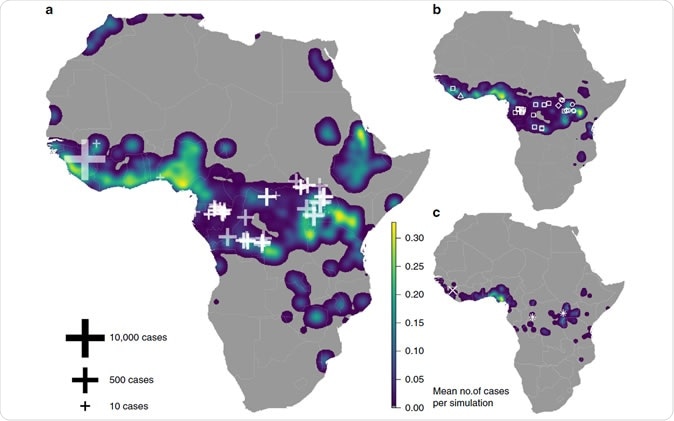The Ebola virus disease (EVD) is a deadly infection that is highly contagious. It has taken thousands of lives across history, with a number of outbreaks mostly happening in West Africa. In the worse outbreak, between 2014 and 2016, there had been 28,616 cases of EVD, 11,310 of whom had died in the continent. Overseas, there had been 36 cases and 15 deaths.

Analysis using a mathematical model shows that several countries in Africa, including Nigeria, could be at risk of Ebola outbreaks both presently, and in the future, despite having experienced no known cases to date. Image Credit: University College London
The outbreaks of Ebola might have patterns and be able to predict where Ebola might strike next, would help save thousands of lives. Predicting where it can rise could now become easier, thanks to a new computer model by researchers at the University College London.
The new computer model can track how changes in human societies and the environment can affect the spread of the Ebola virus. In fact, the computer model predicted that by 2070, Ebola outbreaks could become as much more likely if global warming will persist.
Ebola is a rare but deadly disease. There is no cure, and at present, there’s still no approved vaccine. However, there are experimental vaccines that are being tested against the disease. Almost half of the patients affected by the Ebola virus are at risk of dying from the disease. Today, there is a current outbreak in the Democratic Republic of Congo, prompting scientists to formulate new vaccines and new therapies to reduce mortality related to the infection.
Model predicts future outbreaks
Published in the journal, Nature Communications, the study shows how the team developed modelling methods that capture elements of ecological, socio-economic, and epidemiological factors to predict the risk of Ebola virus disease (EVD) across space and time.
The researchers report that their modelling results matched previously-observed outbreak patterns, hinting that future outbreaks are imminent in West and Central Africa. Designed by the researchers themselves, the computer model captures climate impact, human population factors, and land use factors that contribute to the risk of Ebola outbreaks. The results of the study show that Ebola outbreaks are 1.6 times more likely in scenarios with increased temperatures and slower socioeconomic development.
"It is vital that we understand the complexities causing animal-borne diseases to spill-over into humans, to accurately predict outbreaks and help save lives. In our models, we've included more information about the animals that carry Ebola and, by doing so, we can better account for how changes in climate, land-use or human societies can affect human health,” Dr David Redding of the UCL Genetics, Evolution & Environment, said.
Useful for prompt vaccination and border closure
The new model can help governments and health agencies to make prompt action even before the outbreak happens. They can take measures at country borders where infected travelers might spread the virus, or even help conduct mass vaccinations in the future. The model could also help address other diseases in the future.
It can also help predict other disease patterns, especially those spread by animals. Previous studies have found that disease spread by animals will become more frequent because of climate change and crisis, making more people sick. Since about two-thirds of human infections begin with animals and insects, like mosquitoes, this model can be a big help.
“Importantly, our model is flexible enough to allow us to predict Ebola outbreaks in alternative, simulated versions of the world. For example, we examine a set of plausible future environments and show stark differences in how Ebola responds to the best-case and worst-case scenarios of future climate change and poverty alleviation," Kate Jones, Professor at UCL Genetics, Evolution & Environment and ZSL's Institute of Zoology, said.
What is Ebola virus disease (EVD)?
Ebola virus disease (EVD), formerly known as Ebola hemorrhagic fever, is a rare but fatal disease. The virus ca spread from wild animals to people, and from human to human. The fatality rate of Ebola virus disease is 50 percent.
There is no cure for EVD, but therapeutic measures are performed to relieve the symptoms and prevent complications. The only way to manage the infection is through preventing transmission of the virus.
It was first identified in 1976 near the Ebola River in the Democratic Republic of Congo. Since then, the virus has been infecting people through outbreaks from time to time. Today, several agencies and health experts are formulating vaccines in the hopes of curbing the spread of the fatal disease.
Sources:
Journal reference:
Redding, D., Atkinson, P., Cunningham, A., Lo Iacono, G, Moses, L., Wood, J., and Jones, K. (2019). Impacts of environmental and socio-economic factors on emergence and epidemic potential of Ebola in Africa. Nature Communications. https://www.nature.com/articles/s41467-019-12499-6